Pekingese Dog Breed
The Pekingese, an ancient toy breed, is known for its dignified presence and has been a favorite among dog lovers and historians. With their lion-like appearance and self-assured manner, these small dogs were once exclusive to China’s imperial courts. They are petite yet sturdy but prone to specific health issues that potential owners should consider. Their rich history and traditions are woven into their present-day character and caregiving needs. The Pekingese has remained a beloved pet from China’s emperors to today’s families worldwide.
This toy dog breed is easily recognized by its compact frame and abundant mane, which give it a noble look. Their confidence can be mistaken for aloofness, part of their charm. It’s essential for anyone thinking of getting a Pekingese to understand the breed’s health tendencies. Their past as imperial companions informs their current behaviors and needs. The Pekingese has successfully transitioned from the laps of royalty to being a treasured member of homes across the globe.
Key Takeaways
- Ancient breed: The Pekingese is a storied toy breed.
- Health awareness: Owners should note its specific health concerns.
- Historic charm: These dogs reflect their imperial Chinese origins.
The Pekingese stands as a venerable toy breed. Noting its particular health susceptibilities is wise for owners. Its regal Chinese heritage continues to shape its allure.
Quick Facts
The Pekingese is a small toy breed that stands about 6-9 inches in height and can weigh as much as 14 pounds. These dogs typically live for 12-14 years. They have a striking appearance with a broad, flat face, big eyes, and a coat that looks like a lion’s mane, giving them an air of elegance. Their fur can be any color or mix of colors, as allowed by breed standards.
Chinese emperors once favored these little dogs and carried themselves with a noble and self-assured attitude. They make excellent pets and are also good watchdogs. But their royal background means they’re prone to specific health problems, such as breathing issues linked to their flat faces, eye conditions, and joint issues.
The Pekingese’s thick fur requires regular brushing to avoid tangles and keep the skin healthy. Owners should also be mindful of their exercise needs since too much activity can cause breathing problems.
Pekingese Dog Breed Pictures


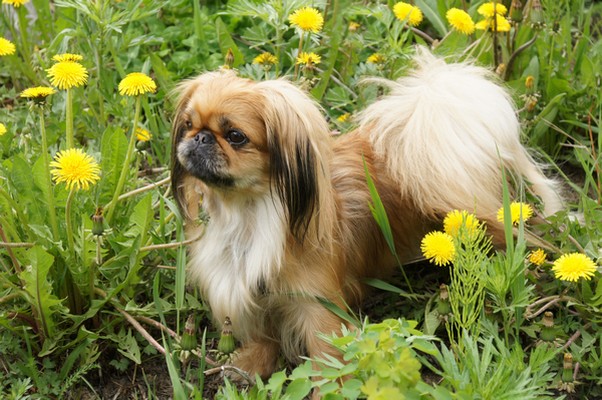
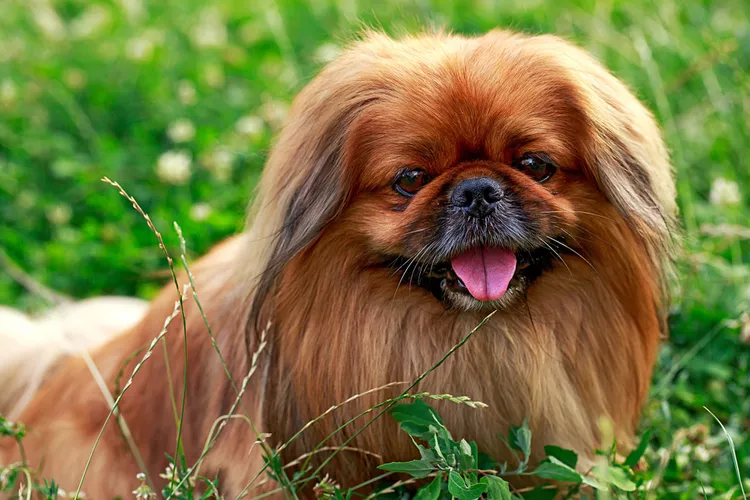
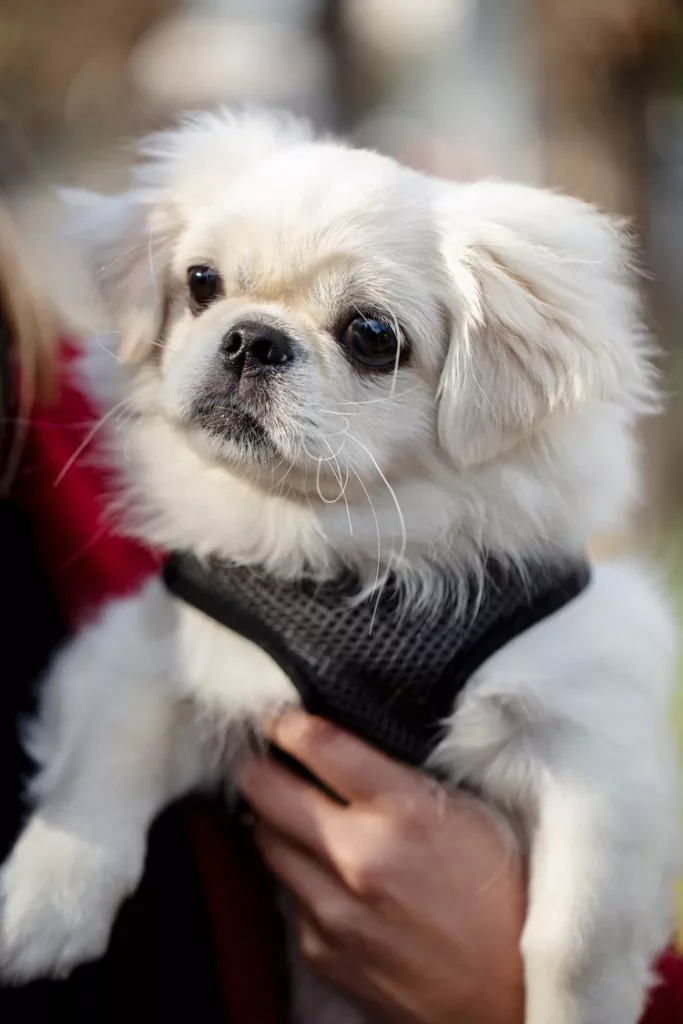
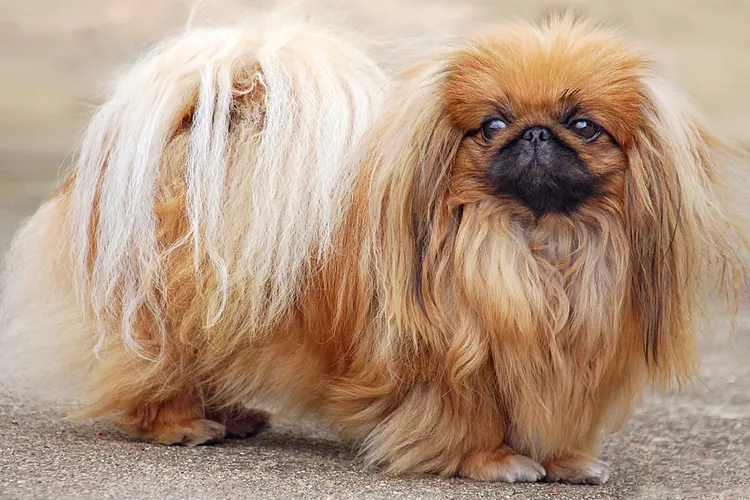
Overview
Pekingese dogs carry themselves with a noble charm and make loyal companions, but they also come with specific needs. Standing only 6-9 inches tall and weighing up to 14 pounds, these members of the Toy Group have a lifespan of 12-14 years. Their luxurious long coat requires regular grooming to avoid tangles and mats, ensuring their appearance remains majestic.
Due to their brachycephalic faces, Pekingese dogs often have trouble breathing. They’re also prone to kneecap dislocation and need their large eyes checked regularly to avoid problems. Their distinctive walk reflects their unique body structure.
These dogs have a history of being cherished by Chinese royalty. Today, their instinct to guard is still noticeable. Pekingese dogs do best with firm training, daily exercise, and careful attention to their health and grooming to maintain their dignified look.
Breed’s Unique Characteristics
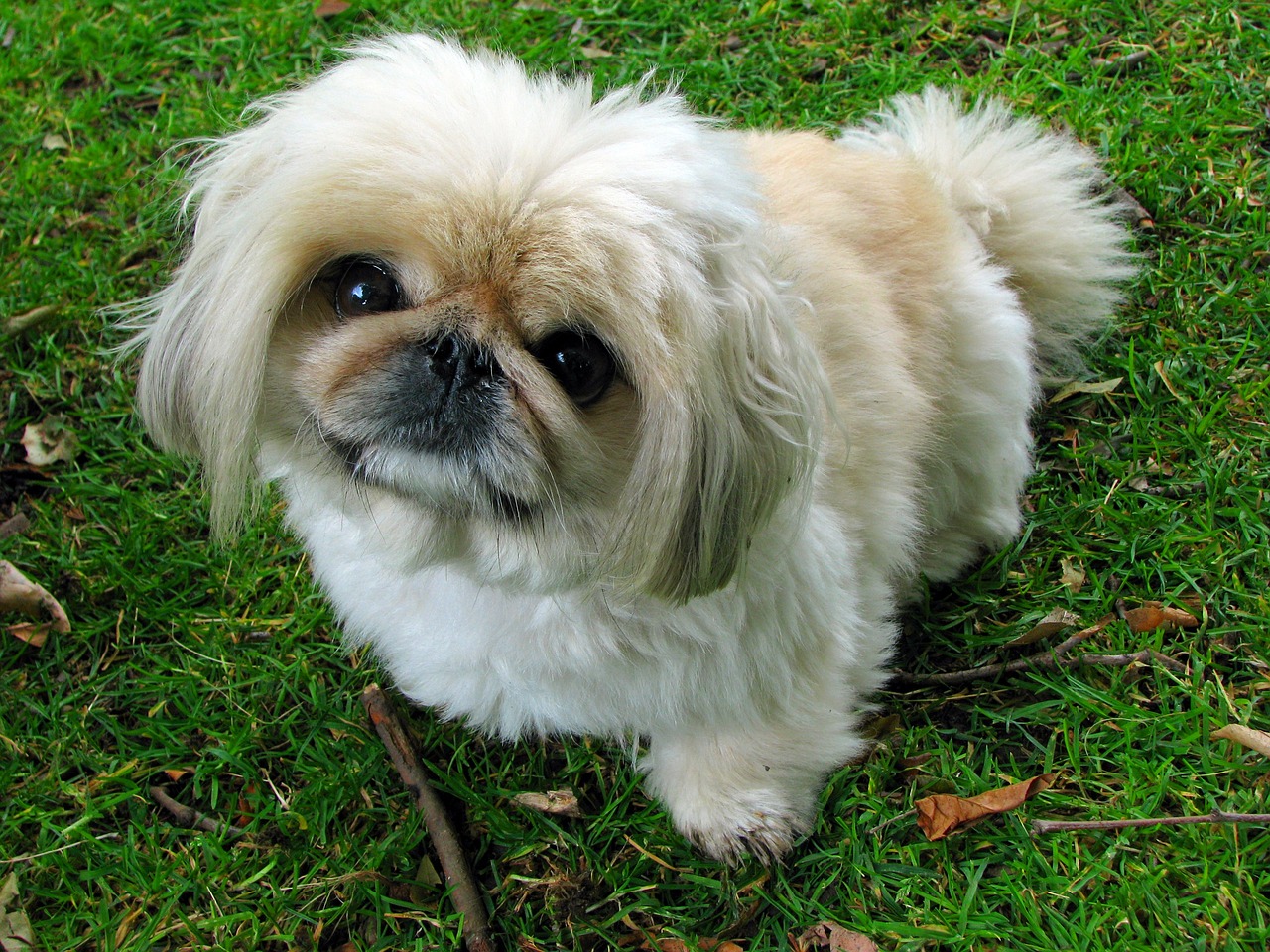
Pekingese dogs are known for their unique walk, which is a result of their specific breeding and their sturdy body shape. These small dogs have a dense, muscular frame, much heavier than one might expect from their size. They were initially bred to be companions, which makes them fiercely loyal and great at forming close relationships with their owners. This makes them perfect pets for the home.
They’re also quite protective, often barking to alert their owners of anything unusual, acting as an effective early warning system. A flat face and large, expressive eyes are standout features of the Pekingese, along with their various coat colors.
Here’s a quick rundown of the Pekingese’s main features:
| Traits | Characteristics |
|---|---|
| Body Type | Sturdy, muscular, with a unique walk |
| Size Perception | Loyal, develop deep bonds, outstanding for companionship |
| Social Behavior | Loyal, form deep bonds, outstanding for companionship |
| Protective Nature | Vocal and alert to changes in their environment |
These points highlight the Pekingese as a breed with a long history and a unique combination of traits that have been refined over time.
Pet Parents Imperial Chinese Origins
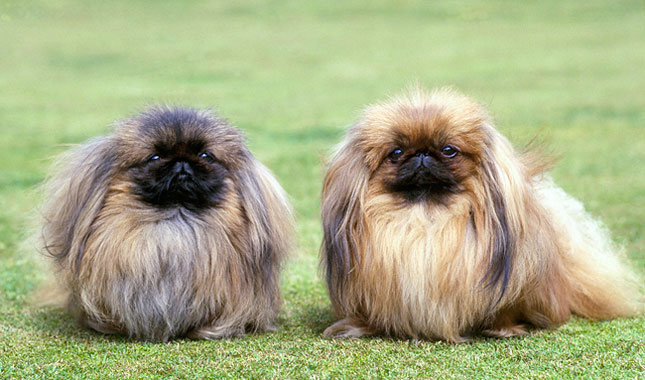
The Pekingese dog breed has a grand heritage that originates from the days of Imperial China. This breed was highly esteemed and often found in the company of Chinese emperors and their families. The Pekingese were integral to the luxurious lifestyle within the Forbidden City. Their history is notable for several reasons:
- The Pekingese had a special bond with the imperial family, serving as exclusive pets.
- Within the majestic walls of the Forbidden City, the breed held a significant place.
- These dogs are often featured in various cultural and ceremonial activities.
- Breeders took great care to maintain the Pekingese’s unique physical traits.
- Major historical events played a part in the Pekingese’s global dispersal.
In rewriting the history of the Pekingese, we see how they were more than just pets; they were symbols of royalty and privilege. Their story tells us about the traditions and values of an ancient civilization. Breeders’ efforts to keep the breed’s distinct characteristics show a commitment to preserving a piece of China’s royal heritage.
The Pekingese breed remains a living link to China’s imperial past despite changes over centuries.
Ancient Royal Companions
Pekingese dogs originated in the Chinese Imperial Palace and were treasured as companions by the royal family, serving as a symbol of their high status. These dogs were exclusive to society’s elite, mirroring the class structure in ancient China. They were seen as an embodiment of imperial elegance, and their arrival in England during the Opium Wars marked a blending of Eastern and Western elite circles.
The breed’s connection to notable individuals like Empress Dowager Cixi and American socialite Alice Lee Roosevelt Longworth highlighted their noble heritage. The Pekingese breed’s victory at the Westminster Dog Show in 2021 is proof of its lasting significance as a breed with a rich history.
Forbidden City History
The Forbidden City is a monumental reflection of ancient China’s grand empires, showcasing emperors’ lavish lifestyle for over 500 years. Built between 1406 and 1420, this vast 180-acre site, recognized by UNESCO as a World Heritage site, was the nerve center of Chinese imperial authority. It took more than a million workers to construct its 90-plus palaces and courtyards, displaying the immense architectural talent and power the Imperial Family wielded.
At the heart of the Forbidden City was the emperor’s residence, strategically placed to emphasize the divine right to rule as dictated by ancient Chinese beliefs. This central positioning underscored the emperor’s supreme status within Chinese cosmology, affirming the revered nature of the Pekingese dogs that roamed these palatial grounds.
Breed Development Stories
The Pekingese dog breed originated within the luxurious confines of the Forbidden City as a cherished pet of the Chinese Imperial family. These dogs were bred for their unique look and temperament, displaying a mane that resembled a lion, an animal held in high esteem in Chinese folklore.
The Pekingese made their way to England due to the events surrounding the conflict known as the Opium Wars in 1860. When British soldiers entered the Forbidden City, they found five Pekingese by the side of their deceased owner. These dogs were then taken to England and gifted to Queen Victoria, and their lineage was mixed with European dog breeds, leading to their spread across the globe.
Compact Stature
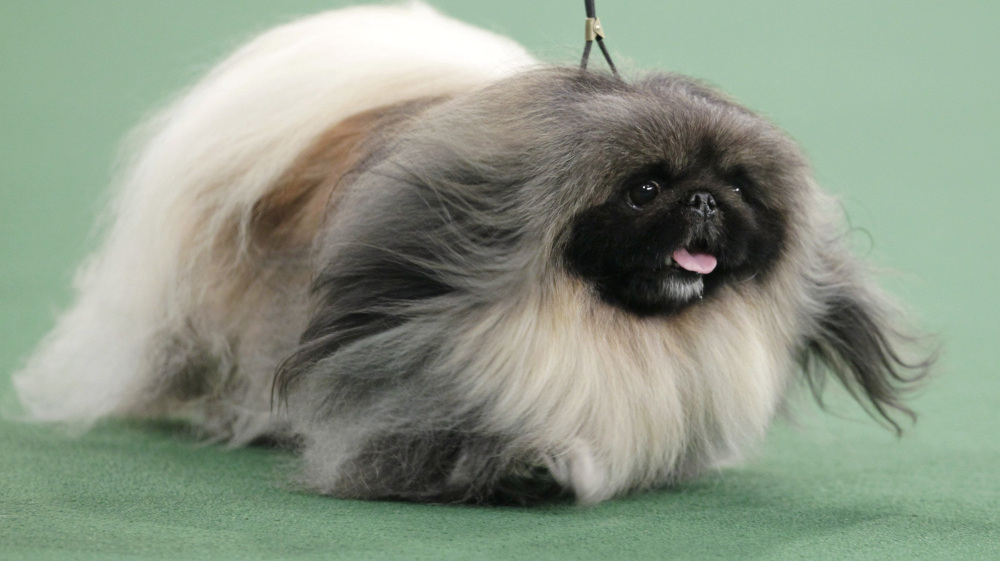
The Pekingese breed stands out due to its small size, an essential feature that significantly affects the dogs and their human companions. The diminutive stature of these dogs shapes many aspects of their lives, from where they live to the health issues they may face. Let’s look at the impact of the Pekingese’s size on their daily life and health.
Breed Size Characteristics:
The Pekingese is a toy breed known for being petite and manageable in size. This makes them ideal companions for those with limited space.
Ideal Living Spaces:
Their small size means they’re well-suited for apartment living. Pekingese can thrive in smaller spaces where they can stay close to their owners.
Physical Build Traits:
Pekingese have a sturdy and solid build despite their small frame. They possess a broad chest and a short, muscular neck, contributing to their distinctive shape.
Movement and Agility:
These dogs are not particularly athletic but enjoy short walks and play sessions. Their size does mean they’re less likely to navigate obstacles or engage in strenuous exercise.
Health Implications:
Their compact build can lead to specific health challenges, such as breathing difficulties and joint issues. Owners should be mindful of these potential problems and seek regular veterinary care.
Understanding these factors can help Pekingese owners provide their petite companions the best care and environment.
Breed Size Characteristics
Pekingese are well-known for their compact size, typically measuring 6-9 inches in height and weighing no more than 14 pounds. This makes them perfect for smaller living spaces like apartments. They have a sturdy, low-slung body that may surprise you with their strength given their small size. Pekingese dogs move with a characteristic waddle, which highlights their solid framework.
Despite being small, they carry themselves with a noble and assertive attitude, often seeming more confident than their size might suggest. Their small yet robust physique makes them great pets for those with limited space, without missing out on the feeling of having a more substantial dog around.
Ideal Living Spaces
Pekingese are perfect for smaller living spaces, like apartments, and are low-energy, fitting the urban lifestyle. Their quiet nature indoors is a plus in areas where peace is valued. They like to get out for walks but don’t need much space to stay content.
Pekingese are adaptable and can bond with anyone, from individuals to retirees, due to their undemanding and friendly character. But, they do best in temperate conditions or where the air is excellent to maintain their well-being.
Physicwell-beingraits
The Pekingese dog is a sturdy little breed with a surprising amount of weight for its size, thanks to its muscular body underneath its fluffy exterior. Its unique body shape leads to a distinctive wobble when it walks; a trait intentionally bred into the breed.
Their flat faces and big, soulful eyes add to their charm, making them stand out in dog shows. The breed’s thick, double-layered coat requires regular brushing to keep it looking good and to prevent health issues.
Movement and Agility
Despite their small size, Pekingese dogs are surprisingly agile and move with a unique rolling walk that highlights their grace and purposeful movement. Their short legs and firm muscles make them good at getting around tight spaces with ease and skill.
These dogs can move quickly when needed, often showing their agility through their rapid and skillful actions. Even though they are small, they can participate in activities that require fast reactions, like dog agility courses.
Pekingese often stand out at dog shows because of their well-coordinated movements and calm presence. Their natural agility and low need for exercise make them well-suited for living indoors, making them flexible and adaptable pets.
Health Implications
Pekingese dogs’ charming looks come with inherent health challenges, such as breathing issues and skin conditions requiring attentive care. Their short, flat faces, shaped through years of breeding, can cause brachycephalic obstructive airway syndrome, leading to a restricted airway and necessitating careful observation to avoid complications.
Given their short legs, Pekingese are also more susceptible to back injuries; thus, limiting their exercise to prevent stress on their spines is crucial.
Keeping these dogs cool in hot weather is vital to prevent heatstroke, as their thick coats and poor ability to cool down can quickly become dangerous.
Consistent grooming is essential for Pekingese, including daily brushing and cleaning their facial folds and rear end to ward off skin infections and keep them healthy.
Temperamental Traits
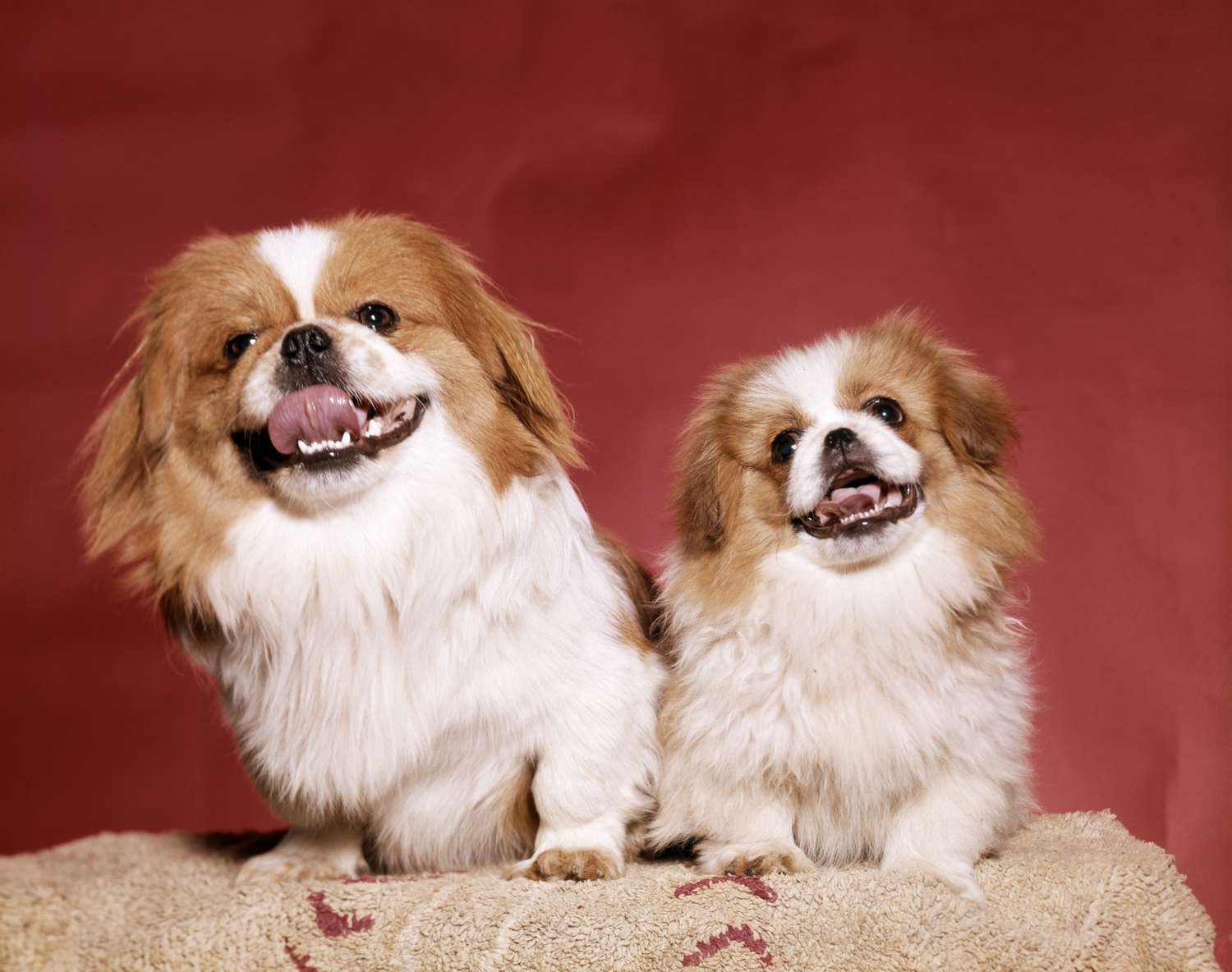
The Pekingese dog breed is known for its distinct personality traits shaping their interactions with the world. Regarding dog training and socializing a Pekingese, it’s crucial to remember their unique history and individual character. To get a complete picture of what makes a Pekingese tick, we should consider these aspects:
Devotion in Companionship
Pekingese dogs are devoted to their owners, often forming a robust and unwavering bond. Their close companionship means they often offer affection and loyalty by your side.
Cleverness and Determination
These dogs are quite intelligent and have a strong sense of determination. This can sometimes make them stubborn, so patience and consistent training are key.
Protective Nature
Their heritage has instilled a strong protective instinct in them. While this can be admirable, it’s essential to manage it properly to prevent overprotectiveness.
Need for Social Interactions
Despite their independent streak, Pekingese dogs do enjoy social interactions. They benefit from regular engagement with people and other dogs to maintain a well-rounded disposition.
Training Techniques
Due to their independent nature, Pekingese can present training challenges. They respond best to positive reinforcement and require an understanding and persistent approach to training.
Loyal Companionship Nature
Pekingese dogs are well-known for their loyalty and form strong bonds with their owners, making them ideal pets for those seeking a faithful friend. These dogs balance their love for independence with a warm affection toward their human companions.
Pekingese may be headstrong sometimes, but they do best in homes where they are treated with respect and have regular company. They may appear reserved, but they are often surprised with playful energy, showing the multifaceted nature of their commitment to their families.
It’s wise to start obedience training early to manage their determined personalities. This can help prevent excessive stubbornness and encourage good manners. Pekingese were once royal guard dogs, and they still carry a sense of protectiveness for their owners, always on alert to keep their loved ones safe.
Intelligence and Willpower
Pekingese dogs are known for their sharp minds and strong determination, which shows how they can grasp new commands. However, they might not always listen due to their independent streak. These dogs learn quickly because they’re smart, but their stubbornness can make training them tough.
To train a Pekingese effectively, you must be patient and keep your training methods consistent, using rewards to encourage good behavior. Pekingese aren’t shy about letting you know what they think, as they are very determined.
For these dogs to thrive, it’s best to involve them in interactive play and activities that challenge their brain, helping to keep them sharp and happy as your loyal pets.
Patience and a steady method are vital to guiding their stubbornness into obedience. Engaging their minds with interactive activities also helps keep them sharp and satisfied.
Guarding Instincts
Pekingese dogs carry a heritage of vigilance from their time as sentinels in ancient China. This history contributes to their alertness and protective behavior. They’re always watchful and quick to sound the alarm if something seems off, making them more than just lap dogs.
Despite their small stature, they take their role as protectors seriously, which is ideal for those wanting a committed and watchful pet. The protective instincts of a Pekingese ensure they’re always on duty, offering peace of mind in a compact package.
Social Interaction Needs
Pekingese dogs have a range of personalities, from being very sure of themselves to being entirely independent. This affects how they get along with people and other pets. Owners need to understand these dogs to ensure they are happy and social.
They are usually friendly toward new people and pets but can be strong-minded. This means they need patience and consistent training to behave well, mainly because they can slowly learn housebreaking. Health issues like breathing and joint problems are also a concern due to breeding practices, so it’s essential to look after them properly.
Pekingese don’t need a lot of exercise but do need to be groomed often to help them be their best around others and stay healthy.
Owners must pay close attention to their distinct personalities to keep Pekingese dogs healthy and social. They often project confidence and can be playful, but their independence can challenge training efforts. Although they usually get along with strangers and other pets, they can be stubborn. This means owners must be consistent and patient when training them, mainly because housebreaking can take time.
Health concerns, such as breathing difficulties and joint issues, are common in the breed and must be carefully managed. Despite their low need for exercise, Pekingese dogs require frequent grooming to maintain their well-being and enswell-being interactions with others.
Training Challenges
Training a Pekingese dog can be challenging due to their independent and stubborn nature. This means trainers need a specialized strategy to teach them effectively. Pekingese dogs are strong-willed and require an owner who can be both firm and patient.
Their occasional playful behavior can help keep them engaged during training sessions as long as the activities are enjoyable. Treats are a good motivator, but avoiding overfeeding these small dogs is essential to prevent health issues.
Consistency and structure are key when crate training a Pekingese, as their stubbornness can make housebreaking difficult.
Pekingese dogs need training that accounts for their personality. Their independence and stubbornness can make training more complex. Trainers must combine firm leadership with patience. Engaging a Pekingese’s playful side can help during training as long as the tasks are entertaining. Treat rewards work well for motivation, but portion control is necessary to keep these small dogs healthy. Crate training requires a regular and organized approach due to the breed’s tendency to resist.
Dog Show Common Ailments
Pekingese dogs, known for their distinct looks, face several health issues that owners must watch out for. Understanding these medical concerns is crucial for anyone looking to adopt or care for a Pekingese. Here are some common health problems they may encounter:
- Breathing difficulties are common due to their short muzzles, which can cause respiratory problems.
- Eye conditions are frequent in Pekingese and can lead to discomfort or vision loss if not treated.
- Knee issues, such as patellar luxation, affect these dogs and hinder their ability to move comfortably.
- Oral health problems often occur in Pekingese, impacting their overall health and requiring dental care.
- Skin allergies can be problematic, especially given their thick fur, making regular grooming essential.
For the health and happiness of a Pekingese, it’s essential to monitor these conditions closely and seek veterinary care when necessary. Regular check-ups and preventative measures can go a long way in managing these breed-specific challenges.
Pekingese Health Conditions
Pekingese puppy, known for their flat faces, often struggle with Brachycephalic Airway Syndrome. This condition, resulting from their unique anatomy, such as narrow nostrils and an elongated soft palate, makes breathing difficult for them. They commonly experience noisy breathing and snoring and are at increased risk when under anesthesia.
These dogs also tend to suffer from dry eye because their shallow eye sockets don’t support adequate tear production, which can lead to discomfort and even harm the cornea without proper care.
Owners of these dogs should keep a close eye on their pets’ respiratory and eye health. Regular check-ups with a vet can catch and address these issues early, improving the dogs’ quality of life.
Managing Dry Eye
Pekingese dogs, with distinctive flat faces, are more prone to respiratory issues due to their brachycephalic build. They often face another challenge: keratoconjunctivitis sicca, known as dry eye. This condition can impair their vision and cause discomfort if not appropriately managed. Owners should watch for signs like frequent blinking, eye redness, or unusual discharge.
Prompt and regular treatment is vital for dogs with dry eyes. Administering eye drops or ointments as a vet prescribes helps keep the eyes moist and the dog comfortable. Regular vet check-ups are necessary to ensure the treatment is working and adjust it if needed. Keeping dogs away from smoke and dust can help prevent dry eyes from worsening. Including omega-3 fatty acids in their diet could improve eye moisture and overall health.
Preventing Patellar Issues
To help keep Pekingese dogs’ knees strong and prevent patellar luxation, a condition they’re prone to, it’s essential to have them engage in regular and moderate exercise. Strengthening the muscles around their knees can be achieved by encouraging gentle activities on the joints. Keeping these dogs at a healthy weight is also crucial, which can be managed through a well-balanced diet. This helps to lessen the pressure on their knees and reduces the chances of joint problems.
Avoiding high-impact activities like excessive jumping or rough playing is essential to protect your Pekingese from injuries that could lead to patellar luxation. Regular vet check-ups play a vital role in the early detection and treatment of knee issues. Additionally, getting advice from a breeder who prioritizes good joint health in their breeding practices can offer further strategies for preventing patellar problems in these dogs.
Grooming Essentials
Proper care for a Pekingese’s grooming needs is vital to their health and appearance. A systematic grooming strategy can improve the dog’s life by focusing on coat upkeep, skin health, and cleanliness. To refine the grooming routine, it’s necessary to consider:
- The ideal frequency of brushing to keep the coat in good condition and prevent tangles
- Effective coat-trimming methods that prioritize the dog’s comfort and ability to move freely
- Bathing practices tailored to the Pekingese’s sensitive skin to avoid irritation
- Regular nail trimming to avert problems caused by nails that are too long
- Gentle eye cleaning techniques to reduce the risk of infection
Caring for a Pekingese involves regular grooming to ensure their coat stays healthy and tangle-free. Brushing them several times a week is usually sufficient. Trimming their coat occasionally helps maintain their comfort and movement. When bathing a Pekingese, use gentle shampoos that won’t irritate their sensitive skin. It’s also essential to keep their nails at an appropriate length to avoid discomfort and mobility issues. Cleaning around their eyes with a soft, damp cloth can help prevent infections.
Brushing Frequency
Regular brushing is crucial for the well-being of your dog’s magnificent coat. Doing this daily helps avoid knots and mats in their fur. Brushing isn’t just for looks; it’s necessary for keeping your pet’s skin and coat in good shape. Work through the thick underlayer and the longer outer coat to prevent mats, especially in areas prone to tangling, like behind the ears and around the legs. This practice keeps the skin and fur healthy with a natural shine and helps with shedding by removing loose hair.
Regular grooming helps keep your home free of pet hair and maintains your Pekingese’s coat. It’s all about keeping your pet comfortable and their coat manageable. Regular brushing distributes essential oils throughout the coat, ensuring it stays shiny and the skin beneath remains healthy. This way, you can keep those common shedding issues at bay and enjoy a home that’s less covered in dog hair.
Coat Trimming Tips
Regular brushing is crucial for keeping a Pekingese’s coat free from tangles and mats. Yet, periodic trimming is essential for the dog’s coat health and overall look. Trimming the fur around the eyes is necessary to maintain clear vision for your pet. Shortening the coat can be especially helpful in hot weather, as it helps prevent the Pekingese from getting too warm.
Proper grooming takes into account the breed’s thick fur and natural shedding. Adjust the trimming routine to match these patterns. This ensures the dog’s coat stays functional and retains the breed’s iconic style.
Bathing Practices
Caring for a Pekingese’s coat is essential to their grooming routine. Their double coat requires a specific approach to prevent knots and maintain skin health. Regular brushing a few times a week is crucial to avoid tangles.
While keeping them clean is essential, too many baths can remove natural oils and cause dry skin. Hence, finding the right balance in their bathing schedule is best.
When cleaning a Pekingese, please pay special attention to the folds on their face to avoid infections. Keep the hair above their eyes trimmed for both health and appearance.
Consider taking your Pekingese to a professional groomer for optimal coat care every six to eight weeks. This ensures that their coat is well-maintained and they stay looking their best.
Nail Care Routine
Nail care is crucial for keeping a Pekingese healthy and comfortable. Maintaining their nails with regular trimming every two to four weeks is essential.
Owners should use sharp, durable clippers for dog nails to prevent splintering. Gradually introducing your Pekingese to nail trimming and rewarding them can make the experience less stressful.
For dogs with dark nails, where the quick is not visible, it is safer to trim small amounts at a time to avoid injury. If you’re unsure how to decorate your dog’s nails properly, seek advice from a professional groomer or vet to prevent mishaps.
Eye Cleaning Methods
Keeping Pekingese’s eyes clean is vital to their overall well-being. Use a well-being cleaning solution and be gentle when caring for their sensitive eye area. A soft, lint-free cloth is best for daily eye care, helping to prevent dryness and keeping the eyes free of debris. Be careful not to scratch the cornea or introduce irritants, as Pekingese are prone to eye problems due to bulging eye shape.
Watch for signs of eye trouble like redness, discomfort, or unusual discharge, and address them promptly to avoid more serious health issues. Regularly trim the hair around the eyes to prevent it from irritating. This maintenance is vital in preventing eye conditions affecting your dog’s vision.
Dietary Requirements
Understanding the nutritional needs of Pekingese dogs is crucial for their well-being. Well-being dogs have specific dietary requirements due to their distinctive physical characteristics. To ensure a Pekingese has a healthy diet, consider these points:
- A balanced diet is critical to meeting their unique energy and metabolic needs.
- Implementing portion control is essential to avoid the risk of the Pekingese becoming overweight.
- Knowing which foods may cause sensitivity in the breed helps prevent dietary complications.
- Supplements might be necessary to prevent and manage health issues common in Pekingese.
- Consult a veterinarian to create a customized diet plan for your Pekingese needs.
Balanced Nutritional Needs
Ensuring a Pekingese gets the proper nutrition is critical for their well-being. A diet of well-being vitamins, minerals, proteins, and fats is necessary for their overall health. It’s a good idea to talk with a vet to customize the dog’s meals based on age, size, and activity. When choosing dog food, look for brands that comply with AAFCO guidelines. These foods are made to meet the unique nutritional needs of Pekingese at various stages of their life.
Including omega-3 fatty acids in their diet can help maintain their distinctive coat in good condition. Regular brushing is also essential to prevent their hair from tangling and to keep their skin healthy.
Portion Control Strategies
Controlling the food intake of a Pekingese is crucial in preventing weight gain and promoting overall health. Measuring each meal with a cup ensures the dog gets the right amount of food based on their activity. It’s better to have scheduled feeding times instead of letting the dog eat whenever, as it helps manage their appetite. Feeding them smaller meals more often can help avoid hunger pangs and is easier on their stomach. Keep an eye on extra snacks and leftovers the dog might get; they should be part of the daily food limit to keep their diet balanced. Always check with your vet to get the proper meal sizes for your Pekingese and adjust them if needed to keep your pet at a healthy weight.
Scheduled feeding and measuring meals are practical strategies. They promote better health in your Pekingese by avoiding excess weight.
Special Dietary Concerns
Caring for Pekingese dogs involves paying close attention to their dietary needs. Due to their small size and health risks, they often require exceptional food to address common issues such as gas, breathing problems, and skin irritation. Consulting with a vet is essential to determine if they have any food allergies and to receive guidance on appropriate diet changes. Additionally, monitoring a Pekingese’s weight is crucial as being overweight can exacerbate their breathing problems caused by their short snouts, a condition known as brachycephalic airway syndrome. It is also essential to prevent joint problems by feeding them the correct amount of food.
Incorporating omega-3 fatty acids into their meals can be beneficial for their skin problems. Additionally, regularly monitoring their food intake in quantity and frequency is necessary to ensure they remain in good shape.
